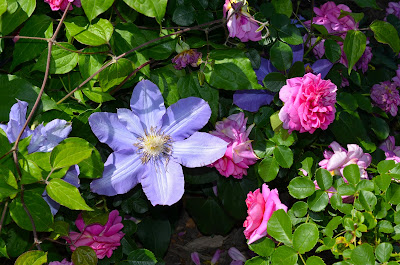 |
When we think about “decking the halls” for the holiday season, most of us envision boughs of holly, evergreen wreaths, and fragrant firs or pine.
But in addition to traditional greenery, one plant has become a Christmas icon -- the poinsettia. With more than 65 million sold each year, this colorful plant has moved from the desert into three-quarters of American homes to become a holiday superstar.
 |
| 'Christmas Joy Marble' |
The poinsettia is a Euphorbia, a succulent from the arid regions of Central
America. It was named after Joel R. Poinsett, a Charleston, S.C. native who was
appointed ambassador to Mexico in 1825. Poinsett was a keen gardener who was
captivated by the plant’s vivid color. The bright scarlet objects many thought
to be “flowers” were not flowers at all, but petal-like leaves called bracts.
The actual flowers are those little yellow dots at the center of the bracts.
Because the yellow flowers and attractive bracts emerge during the holiday
season, the poinsettia has been a part of Christian celebrations for hundreds
of years. In the 17th century, Franciscan priests in Mexico carried poinsettias
in nativity processions. The Aztecs were said to have prized the plant for its
color and medicinal properties.
Although poinsettias were well known in Mexico and Central America, it was a family of German immigrants who spied the plants in the desert and created the Christmas favorite we know today.
In the early 1900s, Albert Ecke and his family left Germany to establish a farm in California. One day his son Paul noticed an unusual plant growing in the wild and decided to develop it as a cut flower. Before long, the family’s fields of poinsettias in Hollywood became a huge tourist attraction.
Of course, the traditional red poinsettia remains the top holiday choice, but interest in white, cream, pink, and mottled varieties is on the increase. In fact, the popularity of the red poinsettia has been steadily falling over the past decade thanks to the introduction of new and more colorful varieties each year. One such variety, 'Ice Punch' is cranberry red with frosty white center markings.
In addition to new colors (PLEASE no glitter-laden or phony blue varieties!) we can thank breeders for giving us plants that last longer and are more vigorous. Today’s poinsettias aren’t too fussy and are relatively easy to care for. Above all, don’t overwater -- plants should be kept on the dry side but don’t allow them to get bone dry. Keep them away from drafts and sources of heat like a fireplace.
 |
| This is just wrong! |
It’s possible to keep a poinsettia alive and blooming from year to year, but like most people, I toss mine out about mid-February. It seems sad and cruel to throw away something that was so lovely during the holidays. But by next Christmas, another showy poinsettia will catch my eye, and this year’s beautiful blooms will be just a happy memory.
 |
| White poinsettias now account for 20% of sales |




























-
Follow Us on Twitter!
-
"Join Us on Facebook!
-
RSS
Contact